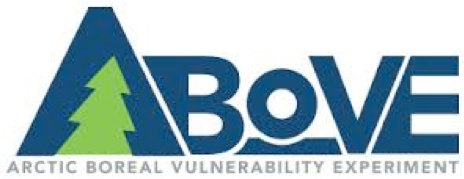Documentation Revision Date: 2022-02-22
Dataset Version: 1.1
Summary
This dataset provides the archived copy of the ABoVE Concise Experiment Plan in pdf format, as well as high-resolution copies of the figures from the document.

Figure 1: The Arctic-Boreal Vulnerability Experiment (ABoVE) is a NASA Terrestrial Ecology Program field campaign that will take place in Alaska and western Canada between 2016 and 2021.
Citation
ABoVE Science Definition Team. 2018. A Concise Experiment Plan for the Arctic-Boreal Vulnerability Experiment. ORNL DAAC, Oak Ridge, Tennessee, USA. https://doi.org/10.3334/ORNLDAAC/1617
Table of Contents
- Dataset Overview
- Data Characteristics
- Application and Derivation
- Quality Assessment
- Data Acquisition, Materials, and Methods
- Data Access
- References
- Dataset Revisions
Dataset Overview
Project: Arctic-Boreal Vulnerability Experiment
The Arctic-Boreal Vulnerability Experiment (ABoVE) is a NASA Terrestrial Ecology Program field campaign based in Alaska and western Canada between 2016 and 2021. Research for ABoVE links field-based, process-level studies with geospatial data products derived from airborne and satellite sensors, providing a foundation for improving the analysis and modeling capabilities needed to understand and predict ecosystem responses and societal implications.
ABoVE Science Definition Team
Eric S. Kasischke (Co-Chair, University of Maryland)
Daniel J. Hayes (Co-Chair, Oak Ridge National Laboratory)
Sharon Billings (University of Kansas)
Natalie Boelman (Lamont-Doherty Earth Observatory, Columbia University)
Stephen Colt (University of Alaska, Anchorage)
Joshua Fisher (NASA Jet Propulsion Laboratory)
Scott Goetz (Woods Hole Research Center)
Peter Griffith [ex officio] (NASA Goddard Space Flight Center/Sigma Space)
Guido Grosse (Alfred Wegener Inst. Helmholtz Centre for Polar and Marine Research)
Forrest Hall (NASA Goddard Space Flight Center/JCET)
Robert Harriss (Environmental Defense Fund)
Jeremy Karchut (National Park Service)
Elisabeth Larson [ex officio] (NASA Headquarters/AAAS Fellow)
Michelle Mack (University of Florida)
A. David McGuire (U.S. Geological Survey)
Donald McLennan (Canadian High Arctic Research Station)
Juha Metsaranta (Natural Resources Canada)
Charles Miller (NASA Jet Propulsion Laboratory)
Michael Rawlins (University of Massachusetts, Amherst)
Robert Striegl (U.S. Geological Survey)
Matthew Sturm (University of Alaska, Fairbanks)
Colm Sweeney (NOAA/ESRL GMD)
Ruth Varner (University of New Hampshire)
Diane Wickland [ex officio] (NASA Headquarters)
Stan Wullschleger (Oak Ridge National Laboratory)
Acknowledgements:
The Science Definition Team would like to acknowledge the contributions of the participants and members of previous workshops and review teams who contributed to the reports and recommendations that provided the foundation for this Concise Experiment Plan. We would also like to thank the individuals and organizations who met with the Science Definition Team and its members, in particular those who took time from their schedules to organize and lead visits to potential research sites or to organize meetings with those interested in collaborating with NASA during ABoVE. Finally, we thank the staff of NASA’s Carbon Cycle and Ecosystems Office who ably supported the Science Definition Team during meetings and in the generation of this report. Writing of this report was funded by NASA's Terrestrial Ecology Program.
Data Characteristics
This dataset provides the archived copy of the updated ABoVE Concise Experiment Plan in pdf format (Updated_Concise_Experiment_Plan_for_NASA_ABoVE.pdf ).
Companion Files:
Also provided are
1. High-resolution copies of the figures from the document (compressed in ACEP_Figures.zip)
2. List of changes to the experiment plan (ACEP_Erratum.pdf)
3. A copy of this user guide document (ABoVE_Concise_Experiment_Plan.pdf)
Application and Derivation
ABoVE aims to build a lasting legacy of research through an expanded knowledge base, the provision of key datasets, the development of decision support products and the fostering of new partnerships.
Quality Assessment
Not applicable
Data Acquisition, Materials, and Methods
Additional information on ABoVE can be found at: http://above.nasa.gov.
Data Access
These data are available through the Oak Ridge National Laboratory (ORNL) Distributed Active Archive Center (DAAC).
A Concise Experiment Plan for the Arctic-Boreal Vulnerability Experiment
Contact for Data Center Access Information:
- E-mail: uso@daac.ornl.gov
- Telephone: +1 (865) 241-3952
References
Dataset Revisions
An updated ABoVE Concise Experiment Plan was released on Feb 22nd, 2022. The updated ABoVE Concise Experiment Plan includes the following updates:
- On page 2, where the date is listed, make a note that “Minor editorial updates were made in 2021”.
- Take out the Figure hotlinks and tiny urls for the figures throughout the document:
- Figure 1.1 – also removed text referencing interactive webmap (The figure number contains a hyperlink to view an interactive web map of this figure: http://tinyurl.com/above-domain.)
- Figure 4.1 (page 40 of document or listed page 34) – also removed text referencing interactive webmap (The figure number contains a hyperlink to view an interactive web map of this figure: http://tinyurl.com/above-spatial-hierarchy.)
- Figure A1
- Figure A2
- Figure A3
- Figure A4 (a) Level II ecoregions
- Figure A4 (b) Tundra vegetation types
- Figure A5
- Figure A6
- Figure A7
- Figure A8
- Figure A9
- Figure A10
- Figure A11
- Figure A12
- In paragraph 1 of Appendix A, remove “Those interested in using this database to explore characteristics of the Study Domain, as well as the wide range of research and monitoring activities that are ongoing in this region can access this database through a webbased GIS system https://above.maps.arcgis.com/home/gallery.html)11 .”
- Remove the footnote at the bottom of Appendix A: “11 The figure number (in blue) of each map listed in Appendix A contains a hyperlink to view an interactive web map of the figure, which can also be found here: http://tinyurl.com/ACEPfigures.”
- Change footnote 12 to footnote 11 after removing previous footnote 11.
- Appendix A Table A1 (p66-67) lists research areas F, G, and H as occurring in Ecoregion/CAVM Subzone “Taiga Shield”. The Ecoregion/CAVM Subzone for Research Areas F, G, and H should read “Taiga Plain”. This was previously in an Erratum posted on the ABoVE site. This has now been removed from the website.